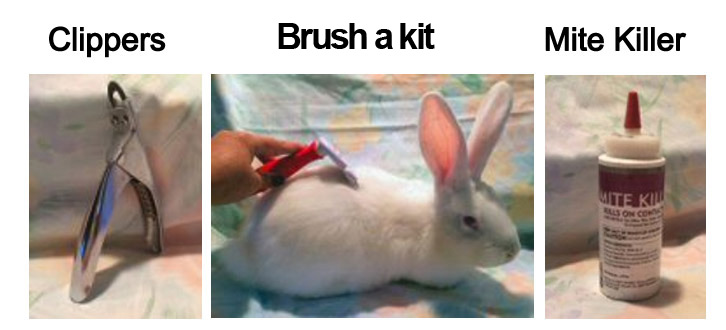Flemish Giants are one of the easiest breeds of rabbits to groom. Being large in size and personality, they enjoy being fussed over once in a while. The importance of grooming is not only due to vanity, by the way. In fact, one of the most beneficial reasons for keeping for Flemish fancied-up is because rabbits do lick their fur, & especially when molting, they can swallow a lot of fur in a short amount of time. This can cause wool-block, which can actually end up being fatal.
Brushing
Their fur is short & dense also, meaning that brushing them is a relatively fast job to accomplish; unlike the wool-breed types of rabbits, as grooming them can take a very long time plus being a quite tedious task. It is suggested to use small wired pet brushes or combs, with closely-placed teeth. Begin at the base of the shoulder, brushing back in long swipes, over their midsection & hindquarters. Use light pressure, as your brush slides along the fur. Pressing too hard to scratch the skin, & doing so will leave you with one unhappy bunny. Once you have covered the entire back, move on to the sides. But don’t be alarmed if your giant refuses to sit thru a head, neck, or feet session because these are more sensitive areas.
P.S. Learn more about the daily care your bunny needs.

Bathing
Another good thing to know is that all rabbits, including Flemish, should NOT be bathed. They typically clean themselves very well. However, the reason not to bathe them is because doing so would be like soaking a thick wool blanket in a sink full of water. It takes a very, very long time & is much harder than what it may appear, to dry out – especially at the skin level. There-within lies the problem; wet or damp areas attract parasites & flies. Those bugs seek out those exact types of areas to lay eggs. This is called Fly Strike. Naturally, those eggs will hatch & then those tiny parasitic creatures will need to eat. What do you think they are going to eat if they are born on your pets’ skin? Yes! That is exactly right… your pet will quickly become bug-food, & this can happen within a matter of hours… obviously a horrible ordeal for your rabbit. It is a wretched thing for you to have to cope with too; that is if you are lucky enough to find this problem before death. Next, rabbits have no way of regulating their body temperature. In essence, they can die from being in above moderate heat or extreme cold.
The heat will cause death much faster than will the cold; but when you add wet or damp skin to that mix, their inability to regulate body temperature causes them to get chilled quickly, thus resulting in a what could become a sick bunny. However, if for some reason there is absolutely no other way to clean your cuddly-friend, & you simply must submerge him in water, then only submerge the area that *must* be cleaned, and add apple cider vinegar to the water; 1/2 cup per gallon water is a good ratio. Quickly clean off what must be cleaned, & then make certain, without doubt, that every single last strand of fur is bone-dry before you leave his side. [note: The Apple Cider variety of vinegar simply smells better to use; the purpose of the vinegar though is that it is a very strong cleaner, it disinfects, & is a parasitic deterrent, plus it 100% safe to use, even if ingested. Otherwise, do not use a hair-dryer either, to dry him with, unless you know ‘exactly’ what you are doing! If not, repeated towel-drying is best.
Make sure to check our other care related pages and learn everything about how to care for a flemish giant! We also included an easy to perform health check.
Conditioning
Next, for those who are involved in showing your big-eared bunny then you may wish to use a special fur-conditioner on his/her fur. Doing this is step should be done a day before showing, but if that is not an option then make sure that your Flemish’s fur is absolutely dry & shows absolutely no signs of having it done by the time it is placed on the show tables for judging. Otherwise, if you decide to use a conditioner, here are the basics on what to do: After brushing out loose &/or molting fur, spray or pour a very small amount of the conditioner on your hands. Rub your hands together, & then quickly rub your hands over the giants back & sides. You’re not aiming to soak the fur. In fact, doing so will cause you a mess of problems, included but not limited to those mentioned in the above paragraph. Instead, you’re just getting the guard-hairs barely damp. Once this is done, fluff-up the fur a few times with your fingers, rub-dry with a towel (cloth or paper), then re-brush it & you’re finished.
Stain removal
Finally, lets talk about those beautiful big white rabbits. If you have or raise White Flemish, you will quickly know what this paragraph is about; urine stains… Yuck! Those terrible dark orange/brown colored stains can ruin the beauty of that pearly white fur. On the show tables, a stained white rabbit is also going to quickly be heavily faulted, & often given the lowest placement in its class. So – How can urine stained rabbits be cleaned up, without giving your bunny a bath? You use hydrogen peroxide. Do this in the same manner as you would use fur-conditioner. Spray or pour a small amount onto your hands, rub your hands together, & rub it into the stained areas. Brush it out, & repeat as much as needed. Once your pals’ pearly white fur is sparkling again, rub the area with a towel (cloth or paper) until completely dry, & you’re ready to go.
